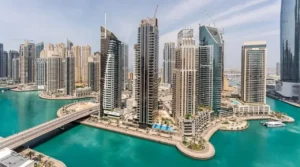Dubai’s Residential Market Continues Growth with 243,000 Units in Development

Dubai’s real estate sector remains strong, with 243,000 residential units planned for completion by 2027, according to a report by property consultancy Cavendish Maxwell. Apartments dominate the upcoming inventory, accounting for 80% of the planned supply.
The market saw unprecedented activity in 2024, with 169,000 property sales—a 42% increase from the previous year. Property prices experienced steady growth, rising by 0.9% month-on-month in December and 3.1% over the last quarter. Year-on-year, prices surged by 16.5%, bringing the cost per square foot to AED 1,493—more than 90% above the April 2009 low.
Dubai has now recorded 47 consecutive months of price appreciation. However, growth rates have begun to stabilise, with monthly increases now averaging 1%, down from earlier spikes of up to 2.5%.
Mortgage activity also reached record highs, with 36,600 loans issued in 2024—an increase of nearly one-third from the previous year. Off-plan sales continue to dominate the market, reaching levels four times higher than pre-pandemic figures. Over 145,000 off-plan units were introduced last year, averaging 400 per day.
Leading developers such as Emaar Properties, Binghatti Properties, and DAMAC Properties played a major role in new project launches, with under-construction developments comprising 68% of total residential transactions.
According to Ronan Arthur, MRICS, Partner and Head of Residential Valuation at Cavendish Maxwell, “These strong figures are not merely a result of post-pandemic recovery but reflect a resilient market that has experienced consistent growth since 2022. Demand from international buyers, particularly from India, China, and the Middle East, has been a significant driver.”
He added, “While Dubai’s housing sector remains strong, we are now witnessing a shift towards more sustainable growth. Market stakeholders, including regulators, developers, and investors, are taking proactive steps to ensure stability and prevent excessive price inflation.”
In 2024, apartments accounted for 81% of transactions, reflecting a 3% rise from 2023. Townhouses made up 13% of sales, while villas comprised 6%, both seeing slight declines compared to the previous year.
Mohammed Bin Rashid City led the way in new housing completions with 5,300 units delivered, followed by Jumeirah Village Circle (4,800), Business Bay (2,800), Al Furjan (2,600), and Rukan in Dubailand (1,500). Looking ahead, Jumeirah Village Circle is set to top the supply list with nearly 25,000 new units by 2027, followed by Business Bay (16,000), Azizi Venice (13,500), DAMAC Lagoons (11,100), and Arjan (9,000).
Jumeirah Village Circle also led apartment sales, with 4,048 title deed transactions and 11,917 off-plan sales. Business Bay followed with 3,400 title deed transactions, while Dubai Marina (2,963), Downtown Dubai (2,289), and International City (1,927) also recorded strong activity. In the off-plan segment, Business Bay saw 6,779 transactions, followed by Dubai Hills (5,487), Mohammed Bin Rashid City (4,156), and Sobha Hartland II (3,957).
Apartment prices rose in most areas of Dubai in 2024, with Barsha Heights recording the highest increase at 33% in Q4 compared to the same period in 2023. Dubai Silicon Oasis saw a 24% rise, while Jumeirah Lakes Towers increased by 21%. In contrast, prices declined in Dubai Production City (-6%), Bluewaters Island (-4%), and Mohammed Bin Rashid City (-2%).
Villa and townhouse prices also climbed across all key areas, with Nad Al Sheba experiencing the highest increase at 54% year-on-year in Q4. Jumeirah Village Triangle followed with a 33% rise, while Dubai South saw a 29% increase.
Despite rapid expansion, market trends suggest a move toward a more balanced and sustainable growth trajectory. With robust demand and a steady influx of new developments, Dubai’s property sector remains a key player in the global real estate landscape.


